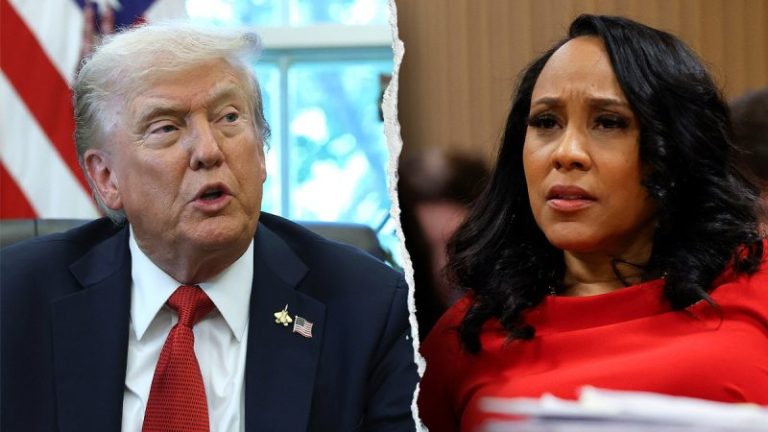Fulton County District Attorney Fani Willis, an elected Democrat, is a disgrace to her office and the legal profession. She to bring down President Trump with a politically motivated indictment, but her vendetta came crashing to a pitiful end on Wednesday. Now, it is time for Willis to face maximum legal accountability.
Trump vigorously objected to the results of the 2020 presidential election in several states and during the Congressional certification process. He offered no bribes and made no threats of violence; indeed, he urged his supporters to march ‘peacefully’ to the Capitol on January 6, 2021, the day of the certification. Yet, Willis—a leftist hack—secured an indictment against Trump and many of his allies with an overwhelming Democrat grand jury in Atlanta. These included Trump’s loyal White House chief of staff Mark Meadows; Jeff Clark, an exceptional former top Justice Department official who is facing a disgraceful disbarment effort by the District of Columbia Bar; and former New York City Mayor Rudy Giuliani, America’s greatest mayor who served as one of President Trump’s attorneys. Willis alleged a vast RICO conspiracy that could have landed President Trump and his supporters in prison for decades.
Willis had ethical issues even before her indictment. Lt. Gov. Burt Jones was one of her targets, but she never got the chance to persecute him. Fulton County Superior Court Judge Robert McBurney disqualified Willis because she had fundraised for Jones’ Democrat opponent. This disqualification was an easy call; indeed, McBurney expressed incredulity as to what Willis possibly could have been thinking. Pete Skandalakis, head of the Prosecuting Attorneys’ Council of Georgia (PACGA), took over the case and dismissed it after determining that Jones had not acted with criminal intent. This shameful episode would not be Willis’s most shocking lapse in judgment during this fiasco.
Willis hired her secret (and married) boyfriend Nathan Wade, who had never tried a felony case. He had been a lawyer in private practice and a municipal court judge. Somehow, he found his way onto Willis’s team, raking in $250 an hour from Fulton County taxpayers. He billed eight-hour days constantly, and he even billed 24 hours on one occasion. He wound up taking home almost $700,000. He made far more money than John Floyd, Georgia’s preeminent expert on the RICO statute. The mystery of Wade’s involvement was solved thanks to Ashleigh Merchant, an excellent attorney who represented one of Trump’s co-defendants and American patriotic warrior Mike Roman. Merchant alleged that Willis and Wade had been having an affair and filed a motion for their disqualification.
Leftist legal analysts like the insufferable Norm Eisen scoffed at Merchant when she filed her motion. The prosecution even sought sanctions. Superior Court Judge Scott McAfee did not issue sanctions; instead, he held an evidentiary hearing. The hearing was a national disgrace. Willis could not control her rage, and McAfee had to caution her to stop her antics. The proceedings degenerated into an episode of Jerry Springer, and the salacious details of the affair were broadcast for the nation to see. Wade paid for lavish trips to the Caribbean and other luxurious places. Willis claimed that she had reimbursed Wade with cash that she kept in her house at the direction of her father, a prominent Black Panther. There are no records of any of these purported reimbursements. Willis also claimed the affair had nothing to do with the indictment, testifying that it only started after Wade’s appointment.
McAfee used the phrase ‘odor of mendacity’ to describe the testimony of Willis and Wade. He sadly split the baby, ruling that one of them would be disqualified. Wade resigned that day, meaning that Willis could stay on the case. President Trump and most codefendants appealed the decision not to disqualify Willis, and an appellate court agreed with the defendants. Willis sought review by the Georgia Supreme Court, but the justices rebuffed her earlier this year. The case was then reassigned to PACGA. Skandalakis could not find a prosecutor to take it over, so he assigned it to himself. The day before Thanksgiving, McAfee granted Skandalakis’ motion to dismiss the case in its entirety. Willis secured a few plea deals to misdemeanor charges, a pathetic result given the fanfare that the indictment initially received. Willis promised that ‘[t]he train is coming,’ but her staggering corruption, arrogance, and incompetence derailed the train.
Willis’s sham indictment devastated many lives. People with not nearly the resources of Trump faced indictment and had to shell out massive amounts to pay lawyers. They had their lives destroyed. The dismissal cannot be the last word here, and Trump’s attorney, the brilliant Steve Sadow, has made that clear. He will move for attorney’s fees and costs under Georgia Code § 17-11-6. Such fees are proper because Willis was disqualified for improper conduct, and the case was fully dismissed. Every other defendant should join Sadow’s motion. Additionally, Willis and Wade must face severe criminal accountability by the U.S. Justice Department for a conspiracy against rights under 18 U.S.C. § 241. Wade visited the Biden White House, billing 16 hours of his time to the taxpayers of Fulton County. What happened here is obvious. Willis and Wade were coordinating their farcical prosecution with Team Biden. It could not have been for any other reason, as Wade was hired as a special counsel just for this case. If Wade were billing his time to Fulton County taxpayers for his Biden White House meeting for an unrelated matter to the Trump case, Wade committed fraud. Willis hired her lover, who kicked back some of his unearned salary to finance lavish trips for himself and Willis. The U.S. Justice Department has subpoenaed records from Willis, and a grand jury must promptly investigate and indict these corrupt public (dis-)servants.
President Trump objected to an election he thought had been stolen. Democrats did the same in 1969, 2001, 2005, and 2017—yet, none faced indictment. Such objections are allowed under the First Amendment and the Electoral Count Act. It is only illegal to object to elections in third-world Marxist hellholes. Willis and Wade were neck-deep in the Republic-ending lawfare conspiracy against Trump that tore apart our nation. They failed, but they cannot walk away from their despicable actions. Justice must come their way swiftly and severely. They could not wait to post President Trump’s mugshot, and the time has come for theirs.
Lawyer up, Fani. Justice is coming. Nobody is above the law.










